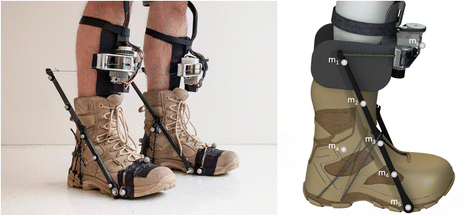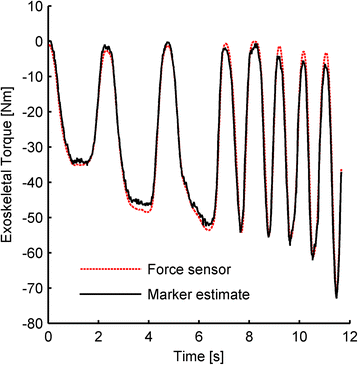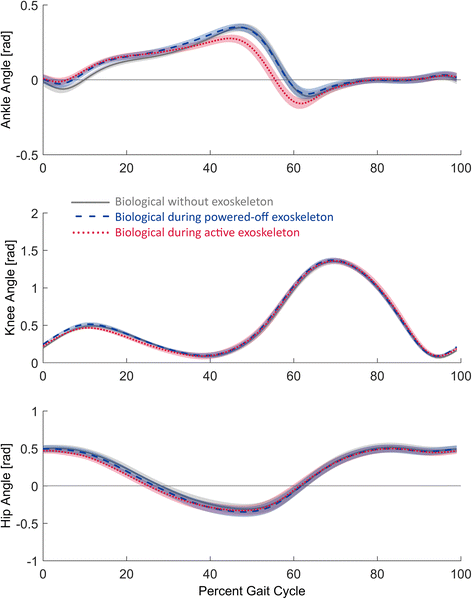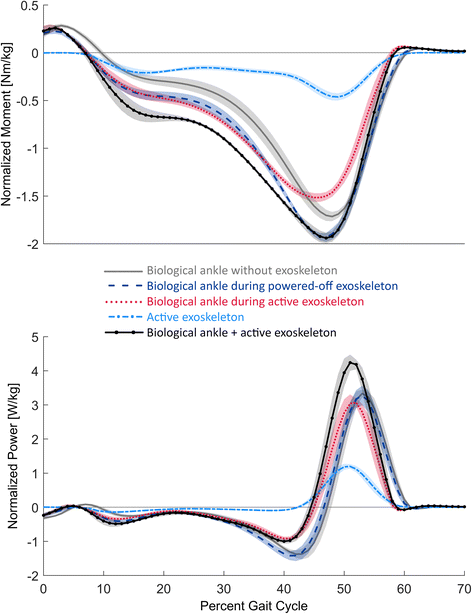Biomechanical walking mechanisms underlying the metabolic reduction caused by an autonomous exoskeleton
- PMID: 26817449
- PMCID: PMC4730720
- DOI: 10.1186/s12984-016-0111-3
Biomechanical walking mechanisms underlying the metabolic reduction caused by an autonomous exoskeleton
Abstract
Background: Ankle exoskeletons can now reduce the metabolic cost of walking in humans without leg disability, but the biomechanical mechanisms that underlie this augmentation are not fully understood. In this study, we analyze the energetics and lower limb mechanics of human study participants walking with and without an active autonomous ankle exoskeleton previously shown to reduce the metabolic cost of walking.
Methods: We measured the metabolic, kinetic and kinematic effects of wearing a battery powered bilateral ankle exoskeleton. Six participants walked on a level treadmill at 1.4 m/s under three conditions: exoskeleton not worn, exoskeleton worn in a powered-on state, and exoskeleton worn in a powered-off state. Metabolic rates were measured with a portable pulmonary gas exchange unit, body marker positions with a motion capture system, and ground reaction forces with a force-plate instrumented treadmill. Inverse dynamics were then used to estimate ankle, knee and hip torques and mechanical powers.
Results: The active ankle exoskeleton provided a mean positive power of 0.105 ± 0.008 W/kg per leg during the push-off region of stance phase. The net metabolic cost of walking with the active exoskeleton (3.28 ± 0.10 W/kg) was an 11 ± 4 % (p = 0.019) reduction compared to the cost of walking without the exoskeleton (3.71 ± 0.14 W/kg). Wearing the ankle exoskeleton significantly reduced the mean positive power of the ankle joint by 0.033 ± 0.006 W/kg (p = 0.007), the knee joint by 0.042 ± 0.015 W/kg (p = 0.020), and the hip joint by 0.034 ± 0.009 W/kg (p = 0.006).
Conclusions: This study shows that the ankle exoskeleton does not exclusively reduce positive mechanical power at the ankle joint, but also mitigates positive power at the knee and hip. Furthermore, the active ankle exoskeleton did not simply replace biological ankle function in walking, but rather augmented the total (biological + exoskeletal) ankle moment and power. This study underscores the need for comprehensive models of human-exoskeleton interaction and global optimization methods for the discovery of new control strategies that optimize the physiological impact of leg exoskeletons.
Figures






Similar articles
-
Autonomous exoskeleton reduces metabolic cost of human walking during load carriage.J Neuroeng Rehabil. 2014 May 9;11:80. doi: 10.1186/1743-0003-11-80. J Neuroeng Rehabil. 2014. PMID: 24885527 Free PMC article.
-
Mechanics and energetics of level walking with powered ankle exoskeletons.J Exp Biol. 2008 May;211(Pt 9):1402-13. doi: 10.1242/jeb.009241. J Exp Biol. 2008. PMID: 18424674
-
Passive-elastic knee-ankle exoskeleton reduces the metabolic cost of walking.J Neuroeng Rehabil. 2020 Jul 27;17(1):104. doi: 10.1186/s12984-020-00719-w. J Neuroeng Rehabil. 2020. PMID: 32718344 Free PMC article.
-
Contributions to the understanding of gait control.Dan Med J. 2014 Apr;61(4):B4823. Dan Med J. 2014. PMID: 24814597 Review.
-
The exoskeleton expansion: improving walking and running economy.J Neuroeng Rehabil. 2020 Feb 19;17(1):25. doi: 10.1186/s12984-020-00663-9. J Neuroeng Rehabil. 2020. PMID: 32075669 Free PMC article. Review.
Cited by
-
From disabled tourists to impaired cyborg tourists: What would it take to transform?Univers Access Inf Soc. 2023 Feb 9:1-18. doi: 10.1007/s10209-023-00970-7. Online ahead of print. Univers Access Inf Soc. 2023. PMID: 36789138 Free PMC article.
-
Biomechanics and energetics of walking in powered ankle exoskeletons using myoelectric control versus mechanically intrinsic control.J Neuroeng Rehabil. 2018 May 25;15(1):42. doi: 10.1186/s12984-018-0379-6. J Neuroeng Rehabil. 2018. PMID: 29801451 Free PMC article.
-
Autonomous multi-joint soft exosuit with augmentation-power-based control parameter tuning reduces energy cost of loaded walking.J Neuroeng Rehabil. 2018 Jul 13;15(1):66. doi: 10.1186/s12984-018-0410-y. J Neuroeng Rehabil. 2018. PMID: 30001726 Free PMC article.
-
Predicting walking response to ankle exoskeletons using data-driven models.J R Soc Interface. 2020 Oct;17(171):20200487. doi: 10.1098/rsif.2020.0487. Epub 2020 Oct 14. J R Soc Interface. 2020. PMID: 33050782 Free PMC article.
-
Challenges and solutions for application and wider adoption of wearable robots.Wearable Technol. 2021 Nov 21;2:e14. doi: 10.1017/wtc.2021.13. eCollection 2021. Wearable Technol. 2021. PMID: 38486636 Free PMC article. Review.
References
Publication types
MeSH terms
LinkOut - more resources
Full Text Sources
Other Literature Sources

